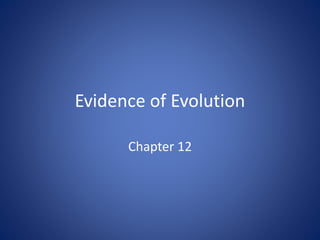
Evidence of evolution
- 4. Fossil Record • Evidence of organisms from long ago • Formed in many ways • Layers of earth show relative age of fossils
- 5. Formation of Fossils • Compression fossil - fossil preserved in sedimentary rock that has undergone physical compression.
- 6. Formation of Fossils • Petrification - organic material converted into stone through replacement of original material with minerals
- 7. Formation of Fossils • Impression – 2- dimensional imprint of organism without any organic material left
- 8. Formation of Fossils • Molds and Casts - original bone or shell dissolves away, leaving behind empty space. • Depression = mold • Cast = space filled with other sediments in the shape of the original organism
- 9. Formation of Fossils • Intact Preservation - Oozing tree sap traps insects and other organisms • Amber - When the sap (or resin) fossilizes
- 10. Dating Fossils • Relative Dating - based on where in layers of rock it is. – Does NOT assign an exact age • Absolute Dating - test fossil or sediment around it to get a date range – Radiometric Dating - uses radioactive isotopes • Based on half life—amount of time it takes for half the substance to decay • Ex. Carbon-14
- 11. Carbon 14 Dating • Carbon dating - used to date samples to the relative dates that the sample was from • Half-life - amount of time it takes for half the radioactive nuclei in a sample to decay • Carbon-14 = 5,700 years
- 12. Biogeography • Biogeography – the study of past and present distributions of organisms • Continental Drift – movement of major land masses due to plate tectonics
- 13. Continental Drift PANGEA 280 million years ago
- 14. Comparative Anatomy • . • Analogous structures - structures that look similar, but have different origins (e.g. wings in birds and insects).
- 15. Comparative Anatomy • Homologous Structures - structures that have a common origin, but may be used for different things
- 16. Comparative Anatomy • Analogous Structures - structures that look similar, but have different origins
- 17. Comparative Anatomy • Convergent Evolution - similar structures due to similar environmental pressures – Body shape of fish, dolphins and ichtyosaurs (extinct).
- 18. Embryology • Embryos show common ancestry – Gill slits in human, chick, fish, amphibian embryos
- 19. Biochemistry • DNA/RNA - All organisms use DNA/RNA and proteins as basis of inheritance – Similar species have similar DNA – Can use whole genomes or single/groups of genes – Mitochondrial DNA – does not degrade as quickly as nuclear DNA – Y Chromosome – accumulates changes more slowly than X – Can use DNA as a molecular clock to estimate when organisms diverged (became different)
- 21. Biochemistry • Proteins – cytochrome c used in electron transport chain of cellular respiration
Notas do Editor
- “Geologic Clock with events and periods” by Woudloper. Released into public domain by the copyright holder
- Geologic Time Scale, “Table of geologic time” https://en.wikipedia.org/wiki/Geologic_time_scale#Table_of_geologic_time. Converted into an image by Lumen Learning.
- Estimating the Age of Fossils. Provided by: Boundless. Located at: https://www.boundless.com/biology/textbooks/boundless-biology-textbook/evolution-and-the-origin-of-species-18/evidence-of-evolution-129/estimating-the-age-of-fossils-520-13098/images/sedimentary-layers/. License: CC BY-SA: Attribution-ShareAlike
- “Compression fossil” https://en.wikipedia.org/wiki/Compression_fossil “Pterodactylus Antiquus p and cp” by Ryan Somma. Licensed under a CC-BY-SA 2.0 Generic license. https://en.wikipedia.org/wiki/File:Pterodactylus_antiquus_p_and_cp.jpg
- “Petrification” https://en.wikipedia.org/wiki/Petrifaction “Petrified wood closeup 2” by Daniel Schwen. Licensed under a CC-BY-SA 3.0 Unported license. https://commons.wikimedia.org/wiki/File:Petrified_wood_closeup_2.jpg
- By Unknown or not provided (U.S. National Archives and Records Administration) [Public domain], via Wikimedia Commons
- Image and caption from Boundless
- Left: “Gouttes Drops Resin 2” by Emmanuel Boutet. Licensed under a CC-BY-SA 3.0 Unported license. https://en.wikipedia.org/wiki/File:Gouttes-drops-resine-2.jpg Right: “Amber 2” by Anders L. Damgaard. Licenced under a CC-BY-SA 3.0 Unported license. https://en.wikipedia.org/wiki/File:Amber2.jpg
- “Carbon-Dating-Flashcards,” by Zappys Technology Solutions. CC-BY. Image from Flikr: https://flic.kr/p/oHNNpJ.
- Public Domain – United States Geological Survey -
- Left: “Pangea” By Kieff. Licensed under a CC-BY-SA 3.0 Unported license. http://commons.wikimedia.org/wiki/File:Pangaea.png Right: “Laurasia-Gondwana” by Lenny Wikidata. Licensed under a CC-BY 3.0 Unported license. http://en.wikipedia.org/wiki/File:Laurasia-Gondwana.svg Bottom: “Eckert 4” by Ktrinko. Licensed under a CC0 1.0 Universal Public Domain Dedication. http://commons.wikimedia.org/wiki/File:Eckert4.jpg
- “Homology Vertebrates” by Волков Владислав Петрович. Licensed under a CC-0 license. https://en.wikipedia.org/wiki/File:Homology_vertebrates.svg
- Image from Boundless
- By Aude Steiner - Self-photographed, CC BY-SA 1.0, https://commons.wikimedia.org/w/index.php?curid=19212453 By Heinrich Harder (1858-1935) (The Wonderful Paleo Art of Heinrich Harder) [Public domain], via Wikimedia Commons By aes256 - http://photozou.jp/photo/photo_only/296250/118149451, CC BY 2.1 jp, https://commons.wikimedia.org/w/index.php?curid=19132968
- “Haeckel Anhropogenie 1874” by J. G. Bach of Leipzig. (Public Domain). http://commons.wikimedia.org/wiki/File:Haeckel_Anthropogenie_1874.jpg
- “Image: Evolutionary Tree” by Boundless, CC-By SA 4.0
- Image by Ahmed376, CC-By SA 3.0, available http://commons.wikimedia.org/wiki/File:Amino_acid_sequence_identity_vs_time_since_species_divergence_for_orthologs_of_EVI5L.png
